Which Of The Following Binds To The Active Site Of An Enzyme To Change Its Level Of Activity?
Metabolism
31 Enzymes
Learning Objectives
Past the finish of this section, you will exist able to do the following:
- Describe the role of enzymes in metabolic pathways
- Explain how enzymes function as molecular catalysts
- Discuss enzyme regulation by various factors
A substance that helps a chemical reaction to occur is a catalyst, and the special molecules that catalyze biochemical reactions are enzymes. Almost all enzymes are proteins, comprised of amino acid chains, and they perform the critical chore of lowering the activation energies of chemical reactions inside the cell. Enzymes do this by binding to the reactant molecules, and holding them in such a way as to make the chemical bond-breaking and bond-forming processes take place more readily. Information technology is important to remember that enzymes do not alter the reaction's ∆G. In other words, they do non modify whether a reaction is exergonic (spontaneous) or endergonic. This is considering they do not change the reactants' or products' free energy. They only reduce the activation energy required to reach the transition state ((Effigy)).
Enzymes lower the reaction'due south activation energy just do not change the reaction's costless free energy.
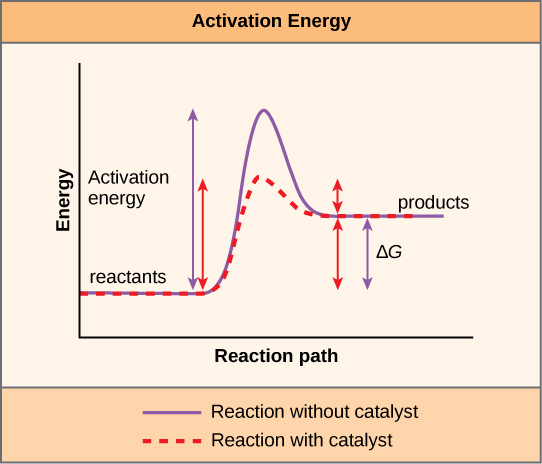
Enzyme Active Site and Substrate Specificity
The chemical reactants to which an enzyme binds are the enzyme's substrates. There may exist one or more than substrates, depending on the particular chemic reaction. In some reactions, a single-reactant substrate breaks down into multiple products. In others, two substrates may come up together to create one larger molecule. Two reactants might besides enter a reaction, both become modified, and leave the reaction as two products. The location within the enzyme where the substrate binds is the enzyme's agile site. This is where the "action" happens. Since enzymes are proteins, there is a unique combination of amino acid residues (also side chains, or R groups) within the active site. Unlike properties characterize each residue. These can be big or small, weakly acidic or basic, hydrophilic or hydrophobic, positively or negatively charged, or neutral. The unique combination of amino acid residues, their positions, sequences, structures, and properties, creates a very specific chemic environment within the active site. This specific environment is suited to bind, albeit briefly, to a specific chemic substrate (or substrates). Due to this jigsaw puzzle-like friction match betwixt an enzyme and its substrates (which adapts to find the best fit between the transition state and the active site), enzymes are known for their specificity. The "best fit" results from the shape and the amino acid functional group's allure to the substrate. In that location is a specifically matched enzyme for each substrate and, thus, for each chemical reaction; withal, there is flexibility besides.
The fact that active sites are so perfectly suited to provide specific ecology conditions also means that they are discipline to local enviromental influences. It is true that increasing the environmental temperature generally increases reaction rates, enzyme-catalyzed or otherwise. However, increasing or decreasing the temperature outside of an optimal range can affect chemical bonds within the active site in such a mode that they are less well suited to demark substrates. Loftier temperatures will eventually crusade enzymes, like other biological molecules, to denature, a process that changes the substance's natural properties. Likewise, the local surround's pH can as well affect enzyme function. Agile site amino acid residues have their own acidic or basic backdrop that are optimal for catalysis. These residues are sensitive to changes in pH that can impair the way substrate molecules demark. Enzymes are suited to function all-time within a certain pH range, and, as with temperature, extreme environmental pH values (acidic or basic) can cause enzymes to denature.
Induced Fit and Enzyme Part
For many years, scientists idea that enzyme-substrate binding took place in a simple "lock-and-key" style. This model asserted that the enzyme and substrate fit together perfectly in one instantaneous step. Nonetheless, current enquiry supports a more refined view scientists call induced fit ((Figure)). This model expands upon the lock-and-central model by describing a more dynamic interaction between enzyme and substrate. As the enzyme and substrate come together, their interaction causes a mild shift in the enzyme's structure that confirms an ideal binding arrangement between the enzyme and the substrate's transition land. This ideal bounden maximizes the enzyme'due south power to catalyze its reaction.
Link to Learning
View an induced fit blitheness at this website.
When an enzyme binds its substrate, it forms an enzyme-substrate circuitous. This complex lowers the reaction's activation free energy and promotes its rapid progression in ane of many ways. On a basic level, enzymes promote chemical reactions that involve more than ane substrate past bringing the substrates together in an optimal orientation. The appropriate region (atoms and bonds) of one molecule is juxtaposed to the other molecule's advisable region with which it must react. Another way in which enzymes promote substrate reaction is by creating an optimal surround within the agile site for the reaction to occur. Certain chemical reactions might go on best in a slightly acidic or non-polar environment. The chemical properties that emerge from the particular arrangement of amino acid residues inside an active site create the perfect environs for an enzyme's specific substrates to react.
You have learned that the activation energy required for many reactions includes the energy involved in manipulating or slightly contorting chemical bonds so that they can easily break and permit others to reform. Enzymatic activity can assist this procedure. The enzyme-substrate complex can lower the activation energy by contorting substrate molecules in such a way as to facilitate bond-breaking, helping to reach the transition state. Finally, enzymes tin can also lower activation energies by taking part in the chemical reaction itself. The amino acid residues tin provide certain ions or chemical groups that really form covalent bonds with substrate molecules as a necessary stride of the reaction procedure. In these cases, it is important to remember that the enzyme will ever return to its original state at the reaction'south completion. One of enzymes' authentication properties is that they remain ultimately unchanged by the reactions they catalyze. After an enzyme catalyzes a reaction, it releases its production(s).
According to the induced-fit model, both enzyme and substrate undergo dynamic conformational changes upon binding. The enzyme contorts the substrate into its transition state, thereby increasing the reaction's charge per unit.

Metabolism Control Through Enzyme Regulation
Information technology would seem ideal to have a scenario in which all the encoded enzymes in an organism's genome existed in abundant supply and functioned optimally nether all cellular atmospheric condition, in all cells, at all times. In reality, this is far from the example. A variety of mechanisms ensure that this does not happen. Cellular needs and atmospheric condition vary from cell to jail cell, and change inside individual cells over time. The required enzymes and energetic demands of breadbasket cells are different from those of fatty storage cells, skin cells, blood cells, and nervus cells. Furthermore, a digestive cell works much harder to process and suspension downward nutrients during the time that closely follows a meal compared with many hours subsequently a meal. Equally these cellular demands and conditions vary, and then do the amounts and functionality of dissimilar enzymes.
Since the rates of biochemical reactions are controlled by activation energy, and enzymes lower and determine activation energies for chemical reactions, the relative amounts and functioning of the variety of enzymes within a cell ultimately make up one's mind which reactions will go on and at which rates. This determination is tightly controlled. In sure cellular environments, environmental factors like pH and temperature partly control enzyme activity. There are other mechanisms through which cells control enzyme action and determine the rates at which various biochemical reactions will occur.
Molecular Regulation of Enzymes
Enzymes can be regulated in means that either promote or reduce their activity. There are many unlike kinds of molecules that inhibit or promote enzyme part, and various mechanisms exist for doing and so. For example, in some cases of enzyme inhibition, an inhibitor molecule is similar enough to a substrate that information technology tin demark to the active site and but block the substrate from binding. When this happens, the enzyme is inhibited through competitive inhibition, because an inhibitor molecule competes with the substrate for active site bounden ((Figure)). Alternatively, in noncompetitive inhibition, an inhibitor molecule binds to the enzyme in a location other than an allosteric site, a binding site away from the active site, and still manages to cake substrate binding to the agile site.
Competitive and noncompetitive inhibition bear upon the reaction's rate differently. Competitive inhibitors touch on the initial rate but practise not touch the maximal rate; whereas, noncompetitive inhibitors bear upon the maximal rate.
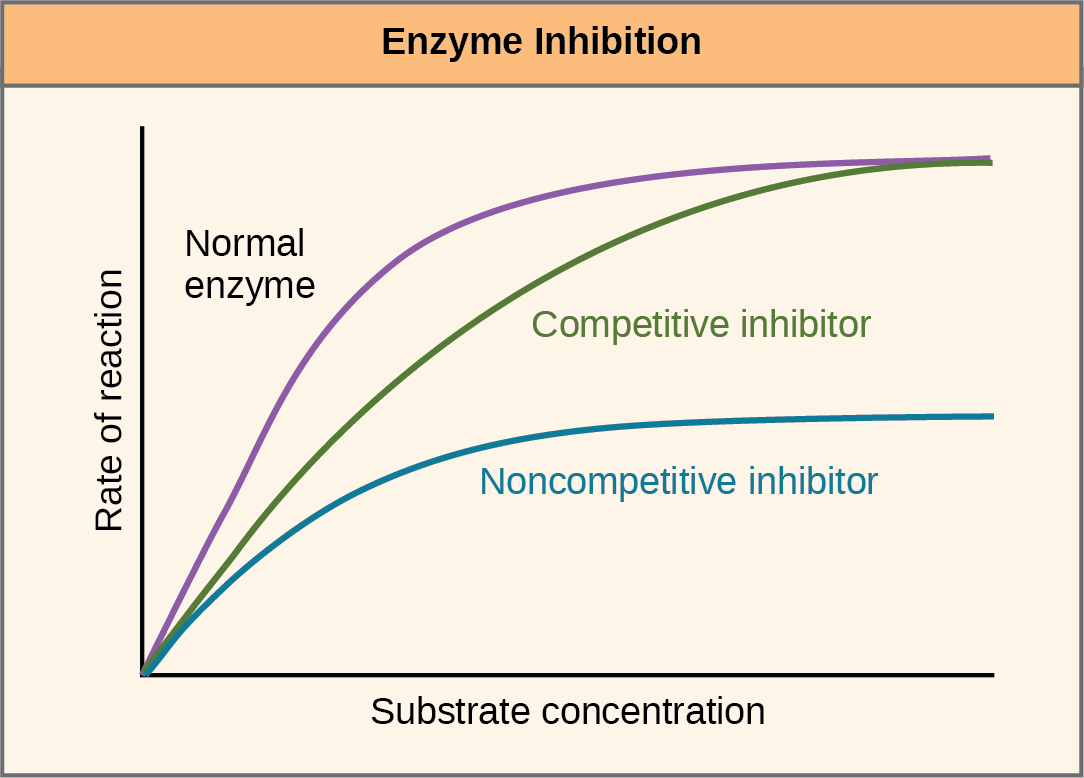
Some inhibitor molecules demark to enzymes in a location where their binding induces a conformational change that reduces the enzyme'due south affinity for its substrate. This type of inhibition is an allosteric inhibition ((Figure)). More than one polypeptide comprise near allosterically regulated enzymes, meaning that they take more one protein subunit. When an allosteric inhibitor binds to an enzyme, all agile sites on the protein subunits change slightly such that they bind their substrates with less efficiency. In that location are allosteric activators as well as inhibitors. Allosteric activators bind to locations on an enzyme away from the active site, inducing a conformational change that increases the affinity of the enzyme's active site(due south) for its substrate(s).
Allosteric inhibitors modify the enzyme'southward active site so that substrate binding is reduced or prevented. In contrast, allosteric activators modify the enzyme'due south agile site and so that the affinity for the substrate increases.
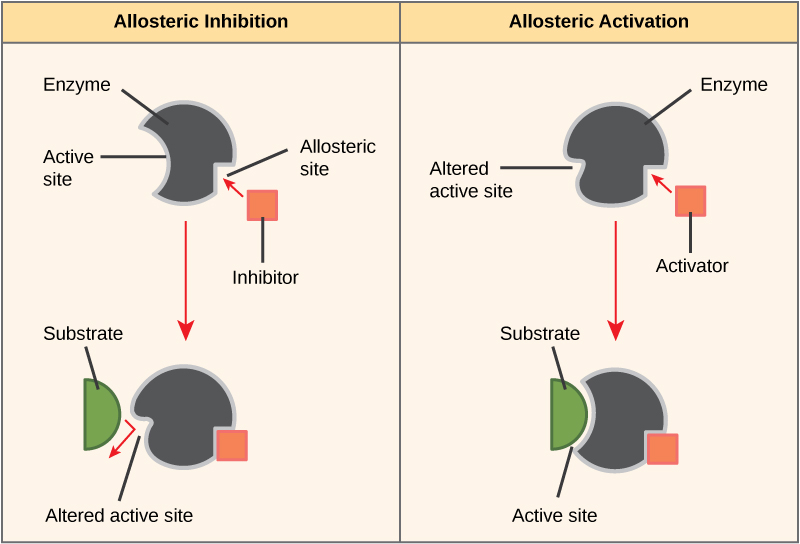
Everyday Connection
Have you ever wondered how pharmaceutical drugs are adult? (credit: Deborah Austin)

Drug Discovery by Looking for Inhibitors of Key Enzymes in Specific PathwaysEnzymes are key components of metabolic pathways. Agreement how enzymes work and how they can exist regulated is a key principle behind developing many pharmaceutical drugs ((Figure)) on the marketplace today. Biologists working in this field collaborate with other scientists, usually chemists, to design drugs.
Consider statins for example—which is a course of drugs that reduces cholesterol levels. These compounds are essentially inhibitors of the enzyme HMG-CoA reductase. HMG-CoA reductase is the enzyme that synthesizes cholesterol from lipids in the body. By inhibiting this enzyme, the drug reduces cholesterol levels synthesized in the torso. Similarly, acetaminophen, popularly marketed under the brand name Tylenol, is an inhibitor of the enzyme cyclooxygenase. While it is constructive in providing relief from fever and inflammation (pain), scientists nevertheless do not completely understand its mechanism of action.
How are drugs developed? 1 of the start challenges in drug development is identifying the specific molecule that the drug is intended to target. In the case of statins, HMG-CoA reductase is the drug target. Researchers place targets through painstaking research in the laboratory. Identifying the target lonely is non sufficient. Scientists likewise need to know how the target acts inside the cell and which reactions go awry in the case of disease. Once researchers identify the target and the pathway, so the actual drug design procedure begins. During this phase, chemists and biologists piece of work together to design and synthesize molecules that tin either cake or activate a particular reaction. However, this is but the beginning: both if and when a drug epitome is successful in performing its function, then information technology must undergo many tests from in vitro experiments to clinical trials earlier it can obtain FDA approving to be on the market.
Many enzymes don't work optimally, or even at all, unless spring to other specific not-poly peptide helper molecules, either temporarily through ionic or hydrogen bonds or permanently through stronger covalent bonds. Two types of helper molecules are cofactors and coenzymes. Binding to these molecules promotes optimal conformation and function for their respective enzymes. Cofactors are inorganic ions such equally iron (Fe++) and magnesium (Mg++). 1 example of an enzyme that requires a metal ion equally a cofactor is the enzyme that builds DNA molecules, Dna polymerase, which requires a bound zinc ion (Zn++) to role. Coenzymes are organic helper molecules, with a basic atomic structure comprised of carbon and hydrogen, which are required for enzyme action. The well-nigh common sources of coenzymes are dietary vitamins ((Figure)). Some vitamins are precursors to coenzymes and others act directly as coenzymes. Vitamin C is a coenzyme for multiple enzymes that accept role in building the important connective tissue component, collagen. An of import stride in breaking downwardly glucose to yield energy is catalysis by a multi-enzyme circuitous scientists telephone call pyruvate dehydrogenase. Pyruvate dehydrogenase is a complex of several enzymes that actually requires one cofactor (a magnesium ion) and five unlike organic coenzymes to catalyze its specific chemical reaction. Therefore, enzyme function is, in role, regulated by an abundance of various cofactors and coenzymes, which the diets of most organisms supply.
Vitamins are important coenzymes or precursors of coenzymes, and are required for enzymes to function properly. Multivitamin capsules ordinarily contain mixtures of all the vitamins at dissimilar percentages.
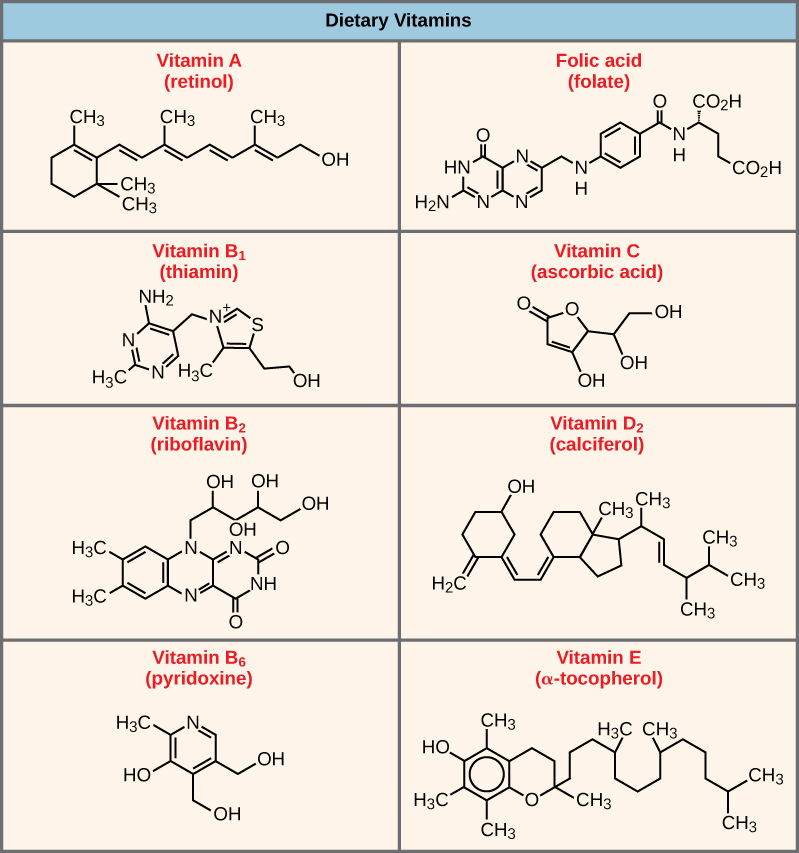
Enzyme Compartmentalization
In eukaryotic cells, molecules such every bit enzymes are usually compartmentalized into different organelles. This allows for yet another level of regulation of enzyme activity. Enzymes required simply for certain cellular processes are sometimes housed separately along with their substrates, assuasive for more than efficient chemical reactions. Examples of this sort of enzyme regulation based on location and proximity include the enzymes involved in the latter stages of cellular respiration, which take identify exclusively in the mitochondria, and the enzymes involved in digesting cellular droppings and foreign materials, located within lysosomes.
Feedback Inhibition in Metabolic Pathways
Molecules can regulate enzyme function in many ways. However, a major question remains: What are these molecules and from where practice they come? Some are cofactors and coenzymes, ions, and organic molecules, as you have learned. What other molecules in the cell provide enzymatic regulation, such every bit allosteric modulation, and competitive and noncompetitive inhibition? The answer is that a wide variety of molecules can perform these roles. Some include pharmaceutical and non-pharmaceutical drugs, toxins, and poisons from the environment. Perhaps the most relevant sources of enzyme regulatory molecules, with respect to cellular metabolism, are cellular metabolic reaction products themselves. In a most efficient and elegant way, cells have evolved to use their own reactions' products for feedback inhibition of enzyme activity. Feedback inhibition involves using a reaction product to regulate its own further product ((Figure)). The cell responds to the abundance of specific products by slowing down production during anabolic or catabolic reactions. Such reaction products may inhibit the enzymes that catalyzed their product through the mechanisms that nosotros described above.
Metabolic pathways are a series of reactions that multiple enzymes catalyze. Feedback inhibition, where the pathway's stop product inhibits an upstream pace, is an important regulatory mechanism in cells.
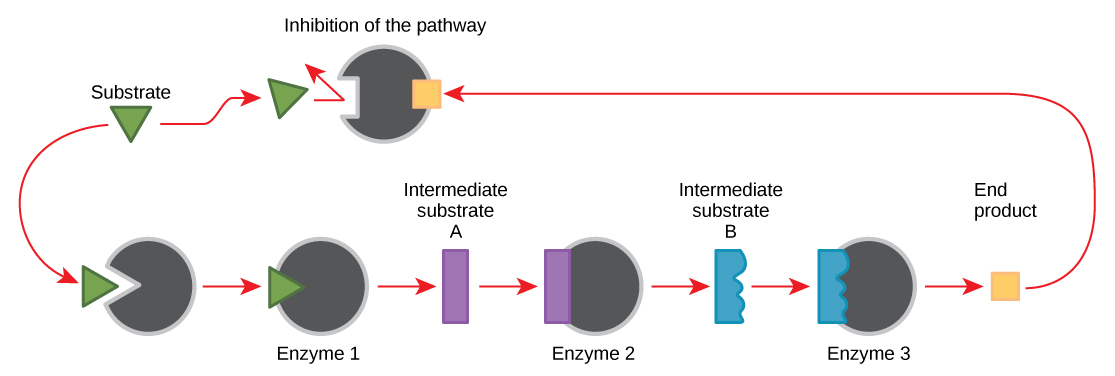
Producing both amino acids and nucleotides is controlled through feedback inhibition. Additionally, ATP is an allosteric regulator of some of the enzymes involved in sugar's catabolic breakdown, the process that produces ATP. In this way, when ATP is arable, the cell can foreclose its further production. Think that ATP is an unstable molecule that tin spontaneously dissociate into ADP. If too much ATP were nowadays in a cell, much of it would go to waste. Alternatively, ADP serves as a positive allosteric regulator (an allosteric activator) for some of the same enzymes that ATP inhibits. Thus, when relative ATP levels are high compared to ATP, the cell is triggered to produce more than ATP through saccharide catabolism.
Department Summary
Enzymes are chemical catalysts that advance chemical reactions at physiological temperatures by lowering their activation energy. Enzymes are usually proteins consisting of 1 or more polypeptide chains. Enzymes have an agile site that provides a unique chemical surround, comprised of certain amino acid R groups (residues). This unique environment is perfectly suited to convert detail chemical reactants for that enzyme, scientists call substrates, into unstable intermediates that they call transition states. Enzymes and substrates bind with an induced fit, which means that enzymes undergo slight conformational adjustments upon substrate contact, leading to full, optimal bounden. Enzymes bind to substrates and catalyze reactions in four different ways: bringing substrates together in an optimal orientation, compromising the bond structures of substrates so that bonds tin can break downward more than hands, providing optimal environmental conditions for a reaction to occur, or participating directly in their chemical reaction by forming transient covalent bonds with the substrates.
Enzyme action must be regulated so that in a given cell at a given time, the desired reactions catalyze and the undesired reactions are not. Enzymes are regulated by cellular conditions, such as temperature and pH. They are also regulated through their location within a jail cell, sometimes compartmentalized and then that they tin can only catalyze reactions under certain circumstances. Enzyme inhibition and activation via other molecules are other important ways that enzymes are regulated. Inhibitors can human activity competitively, noncompetitively, or allosterically. Noncompetitive inhibitors are commonly allosteric. Activators can likewise enhance enzyme function allosterically. The most common method by which cells regulate the enzymes in metabolic pathways is through feedback inhibition. During feedback inhibition, metabolic pathway products serve as inhibitors (usually allosteric) of 1 or more of the enzymes (usually the start committed enzyme of the pathway) involved in the pathway that produces them.
Review Questions
Which of the post-obit is non truthful about enzymes:
- They increase ∆Chiliad of reactions.
- They are usually fabricated of amino acids.
- They lower the activation energy of chemic reactions.
- Each one is specific to the item substrate(s) to which information technology binds.
A
An allosteric inhibitor does which of the following?
- Binds to an enzyme away from the active site and changes the conformation of the agile site, increasing its affinity for substrate binding.
- Binds to the active site and blocks information technology from binding substrate.
- Binds to an enzyme away from the active site and changes the conformation of the active site, decreasing its analogousness for the substrate.
- Binds directly to the active site and mimics the substrate.
C
Which of the following analogies best describes the induced-fit model of enzyme-substrate binding?
- a hug betwixt two people
- a primal fitting into a lock
- a square peg fitting through the square hole and a round peg plumbing fixtures through the round hole of a children's toy
- the plumbing fixtures together of two jigsaw puzzle pieces
A
Disquisitional Thinking Questions
With regard to enzymes, why are vitamins necessary for good health? Give examples.
Near vitamins and minerals act as coenzymes and cofactors for enzyme action. Many enzymes require the binding of certain cofactors or coenzymes to be able to catalyze their reactions. Since enzymes catalyze many of import reactions, it is disquisitional to obtain sufficient vitamins and minerals from the diet and from supplements. Vitamin C (ascorbic acid) is a coenzyme necessary for the action of enzymes that build collagen, an important poly peptide component of connective tissue throughout the body. Magnesium ion (Mg++) is an important cofactor that is necessary for the enzyme pyruvate dehydrogenase to catalyze part of the pathway that breaks down saccharide to produce free energy. Vitamins cannot exist produced in the human body and therefore must be obtained in the diet.
Explain in your own words how enzyme feedback inhibition benefits a cell.
Feedback inhibition allows cells to control the amounts of metabolic products produced. If there is also much of a detail product relative to the cell's needs, feedback inhibition finer causes the cell to subtract product of that item product. In full general, this reduces the production of superfluous products and conserves free energy, maximizing energy efficiency.
Glossary
- active site
- enzyme's specific region to which the substrate binds
- allosteric inhibition
- inhibition past a binding event at a site different from the active site, which induces a conformational change and reduces the enzyme's analogousness for its substrate
- coenzyme
- modest organic molecule, such equally a vitamin or its derivative, which is required to enhance an enzyme'due south activity
- cofactor
- inorganic ion, such as iron and magnesium ions, required for optimal enzyme activity regulation
- competitive inhibition
- type of inhibition in which the inhibitor competes with the substrate molecule by binding to the enzyme's active site
- denature
- process that changes a subtance's natural properties
- feedback inhibition
- a product'south outcome of a reaction sequence to subtract its further production by inhibiting the kickoff enzyme's activity in the pathway that produces it
- induced fit
- dynamic fit betwixt the enzyme and its substrate, in which both components modify their structures to allow for ideal binding
- substrate
- molecule on which the enzyme acts
Source: https://opentextbc.ca/biology2eopenstax/chapter/enzymes/
Posted by: allenundeng1969.blogspot.com


0 Response to "Which Of The Following Binds To The Active Site Of An Enzyme To Change Its Level Of Activity?"
Post a Comment